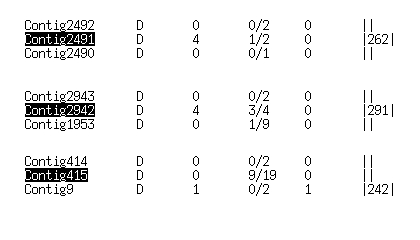UC Davis
Step 13: Python_CAP3_contig_poly_DIS_Feb_27_2004.py output
Upon execution Python_CAP3_contig_poly_DIS_Feb_27_2004.py
three files will be generated:
deletions.good
insertions.good
substitutions.good
Each file has six columns and contains information about polymorphic sites
between different genotypes. For example, look on several example lines in
deletions.good file:

First column - Contig ID; second column - type of polymorphism; third column -
how many times polymorphism (deletion in this example) occurs in one genotype
at the same position of the contig consensus; fourth column - partial polymorphism
(it means polymorphism takes place at the same position but not for all members
of the same genotype); fifth column - priority or confidence (1 is bad); sixth
column - position on the contig consensus.
Click here to read more about "DIS" algorithm.
Next web page displays selected contigs, alignments and detected polymorphic sites
graphically.